
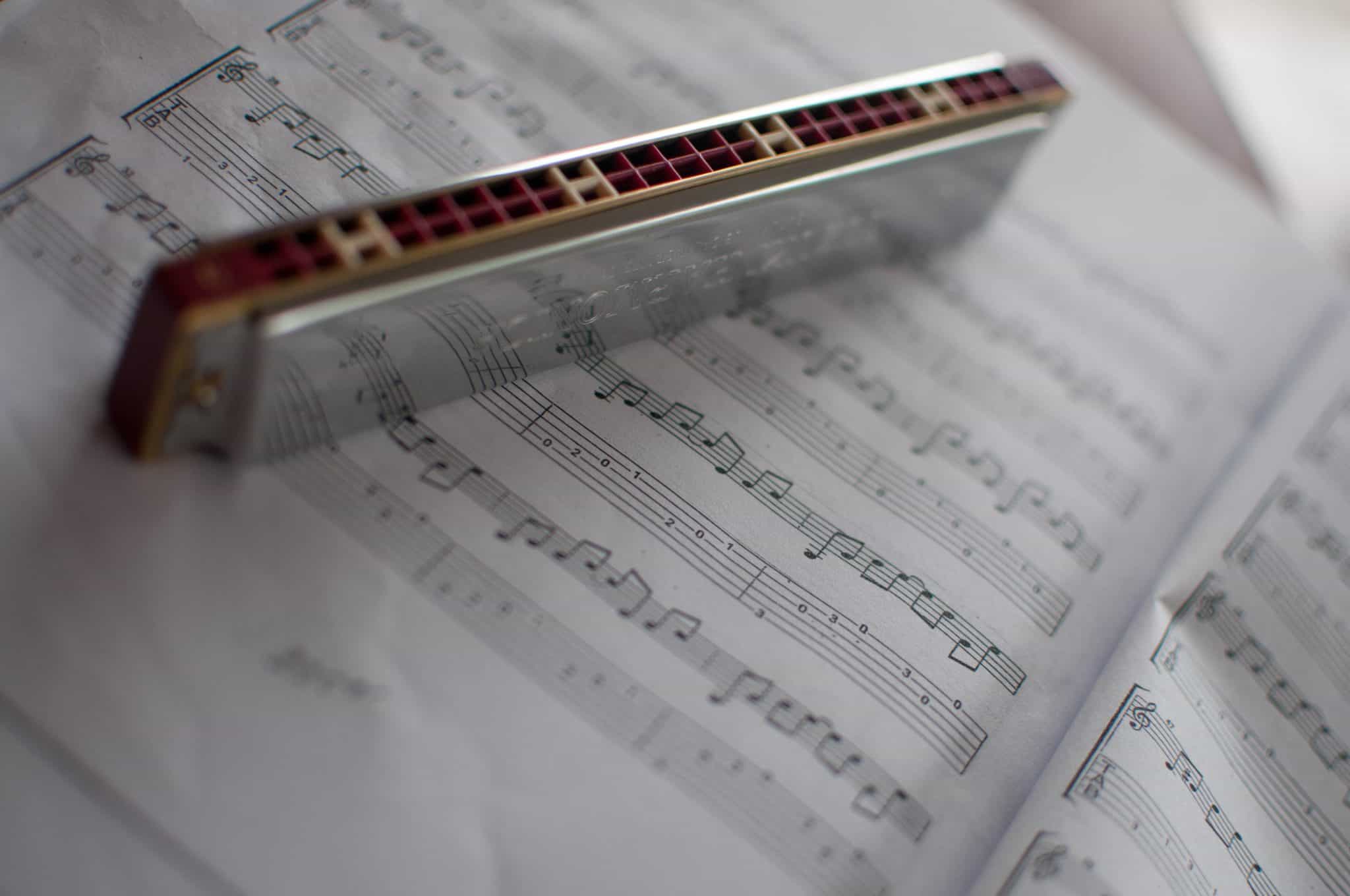
Which are the best harmonicas? You can find out here. Take a few seconds and easily compare several top rated harmonicas.
 Hohner 580BX-G Meisterklasse
Hohner 580BX-G Meisterklasse
Aluminum comb for comfort, sound, and durability
Consistent build means every model is built for quality
Chrome-plated reeds have an exceptional response
Well-designed casing is easy to hold and play
Bends are easy and sound great
A bit on the pricey side for a diatonic harmonica
 Seydel Chromatic Saxony Harmonica
Seydel Chromatic Saxony Harmonica
Matte chrome cover has gorgeous shine
Aluminum comb gives you fantastic tone clarity
Effortless response right out of the box
Heavy-duty plating on reeds for more stable pitch
Well-designed mouthpiece lets you play longer without tiring
Higher price
Slightly tricky to take apart for maintenance
 Suzuki S64 Sirius Chromatic Harmonica
Suzuki S64 Sirius Chromatic Harmonica
Incredible tone quality
Reliable and consistent performance
High attention to detail in the construction
Easy-blowing across the entire range
Wide four-octave range
High price tag, especially for a hobbyist
Hohner Marine Band
Called “the original harmonica” by some, this model gives you a classic tone at an affordable price.
Very affordable
Steady intonation
Pearwood comb gives it a warm tone
Excellent dynamic range
Durable construction inside and out
Plays fast and accurate
Non-modular construction makes repairs costly
Comb may warp, especially from outdoor use
Seydel Blues Session Steel C harmonica
The steel reeds that give this model its name make it more durable and give it a big, bold sound.
More spacing between holes makes it easier to play
Steel reeds last up to five times longer than brass reeds
Cover plate is ergonomic and rounded at the mouthpiece
Handles hard blowing smoothly
Heavy, durable casing
Especially rich in the low end
Models occasionally arrive requiring adjustment
Lee Oskar Major Diatonic Harmonica
The quality of sound and construction you get for the price makes this an excellent option for both beginners and advanced players on a budget.
Bright tone with strong projection
Excellent for bending
Replaceable reed plates extend the life
Precision-molded for reduced air leakage
Easy to play
Can go out of tune more quickly than other models
Plastic comb lacks warmth of wooden versions
Hohner Special 20
This harp’s durability and quick response make it a favorite for pros on the road, though its bends and dynamic range are narrower than other options.
Excellent value
Easy on the lips
Durable and consistent construction
Airtight to guarantee good tone
Smooth, easy bends
Great for beginner and touring professionals
Not as good for deep bends
Occasional and slight flaws in intonation
Suzuki HA20
This sturdy, easy-blowing harp is a unique option with a sound inspired by the Hammond organ.
Solid construction inside and out
Hard carrying case included
Aluminum comb improves dynamics and playability
Stays in tune well
Reeds are durable and easy to replace
Very affordable price
Can take a bit longer to break in than other harmonicas
Black paint on exterior may chip off with heavy use
Hohner Marine Band 5-Piece Set
With five keys Marine Band harmonicas and an included case, this is a very affordable way to expand your tonal possibilities.
Gives you all the most popular keys in one convenient set
Includes a well-designed case
Best per-instrument value of any on this list
Consistent and free-blowing across keys
Beautiful warm tone
Harmonicas can’t be repaired if the reeds give out
Suzuki SCX48G Chromatix
This is the most affordable chromatic harmonica on the list, though it does sacrifice some sound quality in favor of price compared to other professional options.
Great value for a chromatic harmonica
Constructed by hand for top build quality
Airtight and easy to play
Substantial casing makes it more durable
Smooth operation on the slide
Not as good at bending notes
May require more maintenance and fiddling with intonation than other models
11 Perfect Harmonicas for Every Player in 2025

He works as a DJ at night. The main work on a music label. He plays the guitar and a real music lover.
Cecil P. Lindenberg
Even more so than with other musical instruments, you’ll find a wide range of prices and quality levels when you shop for harmonicas. A lot of beginners start playing on the cheap, twenty bucks or less models you can find at toy stores—and you’ll find professionals that play instruments costing well over a grand. Obviously, choosing the best harmonicas will vary depending on the individual's needs and goals.
What makes it even more difficult to sift through these instruments is that a high price doesn’t always mean better quality. You can’t just buy the most expensive option you can find and expect it to be the ideal instrument for you. With harmonicas, there are differences like the key, the tuning, and the materials used that affect both the price and the sound, and are all things you need to consider when you’re buying a new instrument.
This list aims to point out the best harmonicas you’ll find on the market. We’ll rank them based on their overall performance then consider them side-by-side. Not only will you get a chance to see some of your top options, you’ll also be better able to determine just what you’re looking for in a harmonica to get the sound and style you’re seeking.
The most accurate opinions on any musical instrument will come from the people who actually play them, and that’s who we consulted when making this list. We looked at product reviews on a variety of reputable sites. We also talked to professional musicians to find out which instruments they play and recommend. The information that follows in this review is a compilation of all this information, aimed at the general consumer.
The harmonicas included on this list are all excellent options if you’re looking for something that sounds appealing, plays easily, and both looks and feels great in your hands. For more info on how we determined the rankings, the section at the end will go into more depth on it.
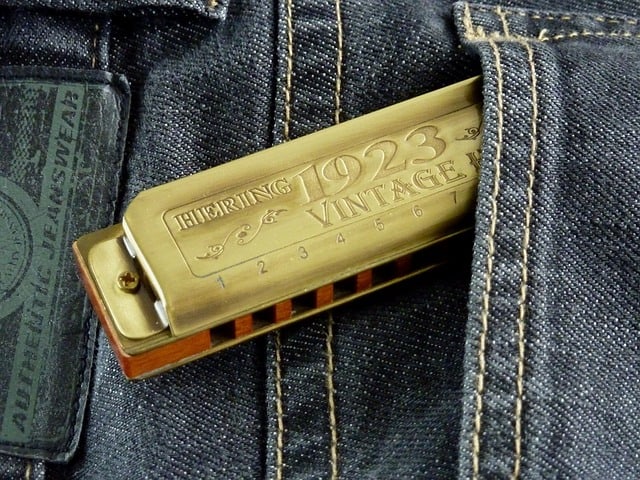
As popular as Hohner’s lower-priced models are, their build quality and expertise really start to shine when you look at less-known models like the 580. It has those intangibles of tone that make it sound vibrant and alive, and it’s much easier to play with a high-level of musicality. The bends and chords are impressive, and it sounds equally good on the blow and the draw.
The aluminum comb is what makes this model so playable. The metal won’t warp like wooden combs, and is also easier on your lips, but has a much fuller sound with richer overtones than you get out of a plastic comb. The chrome plated reed plates are also an improvement over the brass ones you’ll find on the Marine Band and other similarly-priced Hohner models.
The overall design of the 580BX is sleeker. It’s smoother around the edges, which makes it more comfortable to hold as well as less likely to tear up your lips. The details of the construction are spot on across models. You know you’ll get a harp that draws evenly across the holes straight out of the box, without any dead spots that you need to fiddle with and adjust.
Tonally, this harmonica strikes a nice balance between projection and warmth. It’s a versatile, smooth tone that will work well in a wide range of genres, from folk and country to blues and jazz. It’s not only very easy to bend, thanks to the well-designed reed plates, but you can get a wider variety of bend styles and widths, giving you more control over your whole tone.
Aluminum comb for comfort, sound, and durability
Consistent build means every model is built for quality
Chrome-plated reeds have an exceptional response
Well-designed casing is easy to hold and play
Bends are easy and sound great
A bit on the pricey side for a diatonic harmonica
Another option if you’re looking for a chromatic harmonica is the Saxony from Seydel. It just might be the most playable chromatic harp you can find, with a smooth-gliding design and a comfortable lip profile. While it might not be cheap, it’s a well-built instrument that will give you a fast response and big sound.
 Seydel has re-designed the mouthpiece on this harmonica with rounder openings, which puts less strain on your lips when you’re playing. They’ve also re-designed the slider for both comfort and performance. The cover plate has a widened opening at the back to give your sound more overtones, making it richer and fuller.
Seydel has re-designed the mouthpiece on this harmonica with rounder openings, which puts less strain on your lips when you’re playing. They’ve also re-designed the slider for both comfort and performance. The cover plate has a widened opening at the back to give your sound more overtones, making it richer and fuller.
Steel reeds, in general, are known for their clarity. There are fewer overtones generally than with brass reeds, which can make your tone crisper and give it better projection. The tolerance between the reeds and reed plate is very small, making sure you don’t have any leaky air while you’re playing.
The Saxony Chromatic was the first serial-produced chromatic harmonica. This allows them to get the price a bit lower than with other chromatic models. It’s still not cheap, but it comes in at under $500, which is on the lower end of the professional range. If you need a harp that’s not too pricey and will serve you well both on the stage and in the recording studio, this is a great choice.
Matte chrome cover has gorgeous shine
Aluminum comb gives you fantastic tone clarity
Effortless response right out of the box
Heavy-duty plating on reeds for more stable pitch
Well-designed mouthpiece lets you play longer without tiring
Higher price
Slightly tricky to take apart for maintenance
The design of the Sirius was inspired by Suzuki’s Fabulous series, created with the aims of excellence in sound and elegance in appearance. There’s no doubt the Suzuki Sirius is an excellent harmonica. The question is whether it’s tonally superior enough compared to other models to justify the higher price.
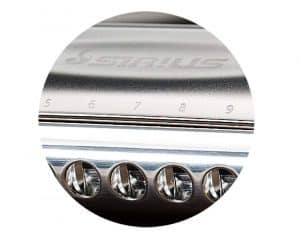 Let’s talk about the tone first. It has solid intonation and a fully saturated sound with lots of rich overtones. If you’re a professional player and need a harmonica that’s appropriate for the studio as well as the stage, this is a definite contender. It has an almost velvety sound when blown gently and has an impressive dynamic range.
Let’s talk about the tone first. It has solid intonation and a fully saturated sound with lots of rich overtones. If you’re a professional player and need a harmonica that’s appropriate for the studio as well as the stage, this is a definite contender. It has an almost velvety sound when blown gently and has an impressive dynamic range.
The build quality is also at a professional level. The solid brass mouthpiece is coated in silver and feels incredibly natural against your lips. The slide action is smooth, and the casing is durable and attractive. It will likely feel a bit heavier in your hand than you’re used to if you’re upgrading from a cheaper model, a sign of the higher-end materials used throughout its construction.
The question, then, becomes one of the price. If you plan to use your harmonica for studio recording, the difference in tone compared to something like the Chromatix will be noticeable. For many players, though, there’s not enough of a difference in sound and playability to justify the significantly higher cost. If money is no object, you’ll be thrilled with the performance of this harp.
Incredible tone quality
Reliable and consistent performance
High attention to detail in the construction
Easy-blowing across the entire range
Wide four-octave range
High price tag, especially for a hobbyist
If you’re looking for something that can give you an extended range, your options can be a bit more limited—and you’ll need to have a much bigger budget. The Super 64X is definitely aimed at professional musicians. It has a sound, build, and look to match the price. It’s the top choice if you’re looking for a high-end model.
This is a chromatic harp with a full 16 holes, and that bigger size is what gives it its increased range. It has double-thick reeds that are more durable and easier to bend than most. They’re responsive and musical, making them great for players in more complex genres, like jazz. Every note is precisely tuned and has a sweet, melodic tone that’s perfect for soloists.
The Super 64X is gorgeous to look at, too. The black lacquered case is elegant with the gold mouthpiece. The milled Plexiglas of the comb is clear, letting you see the reeds within—a nice touch both from an appearance and a practicality standpoint. The exterior build isn’t just about the looks, either. It’s comfortable to hold and easy on your lips. While adjusting to a larger harp might take time if you’ve never had a four-octave model before, it’s well-balanced and fun to play once you’re used to it.
If you’re going to spend this much on an instrument it needs to last a while, and the Super 64X has the durability to do just that. Not only will the reeds last twice as long as typical brass reeds. These instruments are consistently well-built, model to model. The reeds are completely airtight, so you can get a bigger tone with less effort. You can tell just when you hold it that this harmonica will keep playing great for years, even with daily use.
Wide four-octave range
Even and balanced tone from top to bottom
Sleek black and gold design
Sweet, smooth tone
Durable construction inside and out
Comfortable to play
Higher price
You might hear this called the original harmonica. Hohner came out with their first version of this model in 1896, and in over a century of production they’ve come out with over 40 different models that bear the name. They’ve been the model of choice for generations of professional musicians, including famous names like Neil Young and John Lennon. Their current iteration of the design lives up to this history.
There are a lot of features on the Hohner Marine Band you might be surprised to find on such an affordable harmonica. It uses a wood cone, first of all, which adds warmth and resonance to the tone compared to plastic. It also gives you a lot more sound than most harps you’ll find at the price and is easy to adjust for overblowing.
The reeds on this model are worth a mention, too. Hohner’s improved the reed profile over previous models helps the reeds last up to twice as long. Precision die punches are used in the construction to make sure the reeds stay airtight and give you an improved response at any volume. Since it can also get louder than a lot of harmonicas, this gives it one of the widest dynamic ranges you’re likely to find.
The Hohner Marine Band is a workhorse. All the details of the construction give it a long durability. While Hohner harmonicas aren’t modular and will wear out eventually, this one will give you a decent run before it gives out—what most people would consider well more than $40 worth.
Very affordable
Steady intonation
Pearwood comb gives it a warm tone
Excellent dynamic range
Durable construction inside and out
Plays fast and accurate
Non-modular construction makes repairs costly
Comb may warp, especially from outdoor use
This is an upgrade to Seydel’s previous Session model. It has a new look, but there are changes on the inside, too, with an improved reed system that makes it more reliable and easier to play. If you’re mainly looking for a blues harmonica, this is definitely one you want to look into.
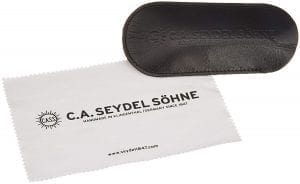 The feature that most sets this one apart from other options is the material used in the reeds. They’re made of stainless steel and set in a recessed German Silver plate. First of all, this makes them more durable, but it also means they can be flatter, reducing the space between the reed and the reed plate. The sound this gives you is clear with a superior response.
The feature that most sets this one apart from other options is the material used in the reeds. They’re made of stainless steel and set in a recessed German Silver plate. First of all, this makes them more durable, but it also means they can be flatter, reducing the space between the reed and the reed plate. The sound this gives you is clear with a superior response.
The tone of this harp is full but it’s also very bright. You’ll get a sound that’s clear and less airy than other models. This is great if you want to project over the sound of a band but some players prefer the warmer tone of a wooden comb. It sounds especially good when you’re playing in the lower range and on the lower keys, with a well-balanced tone that’s consistently in tune.
The Session Steel feels heavier than you might expect. It’s also larger overall. This has a couple benefits. The weight is from the use of metal for more of the components, which translates to an instrument that will last longer and feel sturdy in your hands. The size gives you more space to work with for the same number of holes. There’s more space between them, and the holes themselves are slightly larger, too, which many people find makes it easier to play.
More spacing between holes makes it easier to play
Steel reeds last up to five times longer than brass reeds
Cover plate is ergonomic and rounded at the mouthpiece
Handles hard blowing smoothly
Heavy, durable casing
Especially rich in the low end
Models occasionally arrive requiring adjustment
This is another one that’s highly recommended for beginners. It’s got a high build quality that makes it easy to play without having to put forth too much effort. It’s also got a price tag that seems reasonable if you’re just starting out. While it’s one of the best harmonicas for beginners, that doesn’t mean it sounds like a starter harp. Pros use Lee Oskar instruments for their unique tone and consistent quality, making them a great choice for players of all levels.
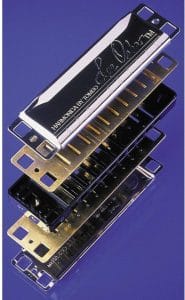 The sound of Lee Oskar harmonicas is bright and clear, making them perfect for rock and country players. The cover is designed to give the reeds more room to resonate, which improves the projection, making this a great option if you’re playing with a louder ensemble. The reeds are close-spaced for quick playing and sit in recessed beds that reduce air leakage. They’re also a lot easier to bend than similarly-priced options, so you can do all the soulful blues riffing your heart desires.
The sound of Lee Oskar harmonicas is bright and clear, making them perfect for rock and country players. The cover is designed to give the reeds more room to resonate, which improves the projection, making this a great option if you’re playing with a louder ensemble. The reeds are close-spaced for quick playing and sit in recessed beds that reduce air leakage. They’re also a lot easier to bend than similarly-priced options, so you can do all the soulful blues riffing your heart desires.
One thing that sets this harmonica apart from similar models like the Marine Band is that you can replace the reed plates if they wear out. Lee Oskar sells replacement plates to fit all their models. They’re mounted to the comb with three self-tapping screws, making it easy to swap them out yourself.
The Lee Oskar Major Diatonic harmonica is arguably one of the best values you’ll find in your search. While purists might turn their nose up at the plastic cone, the sound quality is still fantastic and has an impressive dynamic range. If you want a harmonica you can play hard and not wear out, this is a great one to check out.
Bright tone with strong projection
Excellent for bending
Replaceable reed plates extend the life
Precision-molded for reduced air leakage
Easy to play
Can go out of tune more quickly than other models
Plastic comb lacks warmth of wooden versions
The responsiveness and construction of Hohner harmonicas make them excellent for quick riffs. This is the main reason they’re so popular with professionals, including harmonica legend John Popper. This diatonic harp from their Progressive Series offers every key you’re likely to require, and at a price that lets you buy an assortment without feeling guilty about how much you spent.
The Hohner tone is distinctive. It uses a precision-molded plastic comb with recessed reed plates. The comb is expertly crafted to make sure it’s airtight, which gives every single note the same rich sound. The Special 20 also has decent action on the reeds which makes it easy to bend notes smoothly. If you’re going for an extreme blues bend it might not cut it, but it’s perfect for genres like folk and rock.
All of the harps in the Special 20 line are diatonic to a major key, but they also give you the choice of using the more specialized Country Tuning when you play in the cross harp position. This gives it a lot of versatility, making it a great choice for all kinds of different genres.
Touring musicians will love the durability of this harmonica, as well. Because the comb is plastic it won’t absorb moisture, either from your breath or from the atmosphere, and this means it won’t warp or lose consistency over time. The cover is durable stainless steel and well-built consistently across keys and models.
If you’re looking for a harmonica that’s easy to play, sounds great, and is an excellent value, this Hohner will satisfy all your needs. It’s affordable enough even a beginner can get a couple keys to play around with but still gives you the tone quality a pro demands.
Country tuning is one of many alternate tunings you can use for the harmonica, and it’s not limited to country. Players in a variety of genres find it useful for more melodic playing. You can do it by tuning the draw 5 plate up by a half-step. This relatively minor adjustment gives you a lot more sound options, especially if you’re mostly playing in major keys.
Excellent value
Easy on the lips
Durable and consistent construction
Airtight to guarantee good tone
Smooth, easy bends
Great for beginner and touring professionals
Not as good for deep bends
Occasional and slight flaws in intonation
If you want to get the sound of a Hammond organ in the convenience of an instrument you can carry around in your pocket, the HA20 mouth organ made by Suzuki will give you the deep, rounded tone you’re after. It also has a beautiful black casing and a unique construction that sets it apart from other options on the market.
The tone of the HA20 is uniquely rich and mellow, but without losing its clarity. It’s also incredibly easy-blowing. A lot of other inexpensive harmonicas require you to use a different amount of air pressure for the low notes than the high, but with the HA20 you can use a consistent air pressure regardless of the frequency. This lets you use changes in the air pressure to alter the dynamics instead. It can play quietly when you want it to, without losing the tone quality. The aluminum comb lets it get louder than a lot of other harmonicas, too.
You’ll get great control and precision with the HA20. The notes you blow through any given hole are clear and locked into the pitch. It gives you equal definition whether you’re playing chords or single-note melodies and riffs. Note bends are easily accomplished and sound fantastic. Combined with the warmth of the tone, the quality of the bends makes this an awesome harmonica for blues players.
The solid build on this harp is also worth pointing out. The outer casing is heavy-duty and will stand up to lots of play and abuse. The reed plates and comb are also well-made, and the entire unit is well-constructed to prevent air leakage. The small details are on point, too. There are finger grooves on the cover plate to make it easier to hold, and the embedded lip guidelines in the comb are more comfortable and enjoyable play.
Solid construction inside and out
Hard carrying case included
Aluminum comb improves dynamics and playability
Stays in tune well
Reeds are durable and easy to replace
Very affordable price
Can take a bit longer to break in than other harmonicas
Black paint on exterior may chip off with heavy use
This is the same harmonica that appeared already on the list above but in a five-instrument package that includes a convenient slotted carrying case for easy transportation. This easily makes it the best value per piece on the list. If you know you’re going to need a wide range of keys, this will give you the most often-used tonalities in one fell swoop, though it is a larger one-time investment.
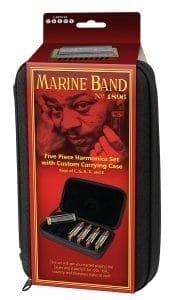 There are a lot of situations in which this kind of a package is a great option. Players moving up from the beginner to the intermediate level or those who want to start playing with other people will get a lot of use out of this package. It’s also an attractive choice for gigging players who want to get a set of harps to take on the road. The carrying case has seven total slots and will fit any standard harmonica, not just Hohner models, so you can easily keep all your instruments protected.
There are a lot of situations in which this kind of a package is a great option. Players moving up from the beginner to the intermediate level or those who want to start playing with other people will get a lot of use out of this package. It’s also an attractive choice for gigging players who want to get a set of harps to take on the road. The carrying case has seven total slots and will fit any standard harmonica, not just Hohner models, so you can easily keep all your instruments protected.
The keys that come included with this set will cover most of your needs, especially if you mostly play in folk or rock ensembles. One of the things that make the Marine Band so attractive is that it’s very consistent across the keys. This is great if you do a lot of switching during your set since you won’t have to readjust every time and you can just stay in your groove.
The total price of this package may seem a bit steep for hobbyists. If you’re going to be playing with other people, though, having a range of keys to choose from will be very helpful, letting you play a wider variety of songs. If you’ll be getting these keys anyway, getting this package is a smart move.
Gives you all the most popular keys in one convenient set
Includes a well-designed case
Best per-instrument value of any on this list
Consistent and free-blowing across keys
Beautiful warm tone
Harmonicas can’t be repaired if the reeds give out
You can get chromatic harmonicas that are a bit more budget-friendly. The Chromatix from Suzuki comes in at just over $200 at the time of writing, making it one of the most affordable options for a chromatic harmonica.
The construction quality of this Suzuki model is still high, despite the low price. Music experts construct each instrument, so you can be sure each model they put out has been vetted for consistency and quality. The detail work on the casing is also top-notch, with an ergonomic mouthpiece and a smooth slide. This also prevents any air from leaking through, which enhances both the sound and playability.
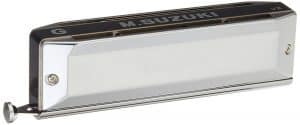 The materials used are where you can tell this harmonica is on the “budget” side of things. Similar to many of the more affordable diatonic models above, the comb is made of ABS plastic, with Phosphor bronze reed plates. This combination of materials gives you a classic blues harp sound but isn’t as loud, clear, or easy to bend as other options.
The materials used are where you can tell this harmonica is on the “budget” side of things. Similar to many of the more affordable diatonic models above, the comb is made of ABS plastic, with Phosphor bronze reed plates. This combination of materials gives you a classic blues harp sound but isn’t as loud, clear, or easy to bend as other options.
Having said that, this is still a substantial instrument that will feel great in your hands. The reeds are highly responsive to varying degrees of air pressure and have a decent dynamic range. It’s also very durable inside and out. While all reeds will wear out eventually from enough play, the pieces of this harp are well-designed and long-lasting and will serve you well for daily playing.
The Suzuki Chromatix is a fine instrument that only ranks as low as it does on the list because it’s the right choice for a smaller segment of the population. It’s a good option for an advanced hobbyist who wants to experiment with chromatic harmonicas but doesn’t want to spend a whole ton of money. It’s also a great choice for pros on a budget who need the expanded tonal options a chromatic harp gives you but can’t afford something like the Suzuki Sirius.
Great value for a chromatic harmonica
Constructed by hand for top build quality
Airtight and easy to play
Substantial casing makes it more durable
Smooth operation on the slide
Not as good at bending notes
May require more maintenance and fiddling with intonation than other models
Tone quality was our number one consideration when we put together this list. For an instrument to be one of the best harmonicas, it has to sound great, period. Beyond this, though, there were a few other considerations that factored into our decision.
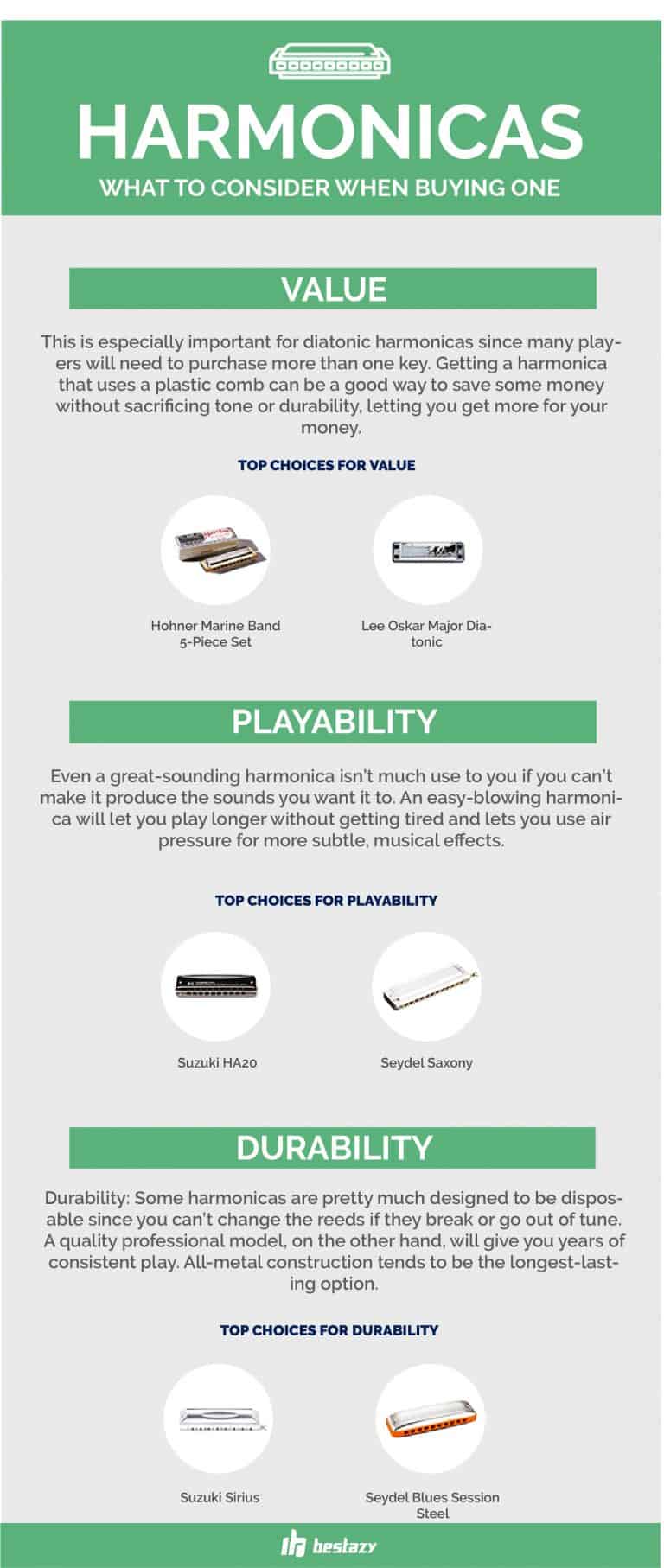
The best harmonicas don’t get the title from just one factor. You should consider your choice using all your senses. The feel of the instrument when you play it is just as important as the sound it produces. Don’t forget about the aesthetic qualities, either; an instrument that looks good is often a sign that the inside was designed with the same care and attention to detail.
There are a lot of different types of harmonica out there, beyond even the kinds you’ll find on this list. In general, though, there are two you’ll find to be the most universally popular:
When you’re shopping for a new harp, the first decision you need to make is what style you want to buy.

The diatonic harmonica is the most common kind. It has ten holes and each harmonica will be focused on playing in a single key. You can buy them in all 12 major keys; most people start with the key of C and expand their tonal options from there.
The typical diatonic harmonica gives you 19 notes across three octaves, all of which are included in the major scale of the harmonica’s key. For example, if you buy a C diatonic harmonica, you’ll get various octaves of the notes C, D, E, F, G, A, and B, but none of the sharps or flats between them. You may also see this style called a Richter tuned harmonica or simply a blues harp.
The chromatic harmonica, on the other hand, lets you play all 12 notes in any given octave. This makes them more suitable for harmonically complex genres, like jazz. They give you a wider variety of tonal options by using a slide to redirect your air stream, expanding the number of notes the instrument can produce.
You’ll find more design variation when it comes to chromatic harmonicas. They may be available with anywhere from 8 to 16 holes. They also come in different keys, though with chromatic harmonicas this affects the range of the instrument rather than which notes they’ll play.
The most common iteration for a chromatic harmonica is to have 12 holes, giving you 48 notes across three octaves. These versions tend to be the easiest to play and learn, and it’s a good option for beginner or intermediate players. The largest chromatic harmonicas have 16 holes, giving you an extra octave below the 12-hole’s lowest note. These harmonicas are generally best for more advanced players, since learning to take advantage of the instrument’s full range can take a lot of practice.
Diatonic versions are the best harmonicas to start with if you’re a relative beginner.
Learning the technique is easier and you’ll be more likely to sound good even if you don’t get the notes quite right. The added semi-tones and slide on a chromatic harmonica make it a bit trickier to play. Since you can play semi-tones, you also have a greater chance to hit a “wrong” note, meaning you have to be more confident with your technique to sound good playing it.
The term action means a different thing for a harmonica than it does for stringed instruments like the guitar, though the basic premise is the same. It’s a term that refers to how easily the reeds respond to changes in air pressure. You can adjust the action on a harmonica by bending the reeds or adding shims to give them more distance from the reed plates. The Harmonica for Dummies blog has a great post on how to do this that you can read at.
The materials used in the construction of the harmonica are what will determine the specifics of the instrument’s tone. Aside from considerations like overall build quality, it’s the most important thing you’ll need to consider once you’ve decided what size of instrument you’re looking for.
There are three major areas of the harmonica, which will often each be made from a different material:
All three of these areas will have an impact on the sound, but the material in the comb and reeds is especially important since it will also affect the instrument’s playability. As a result, these are also the areas where you’ll see the most variation.
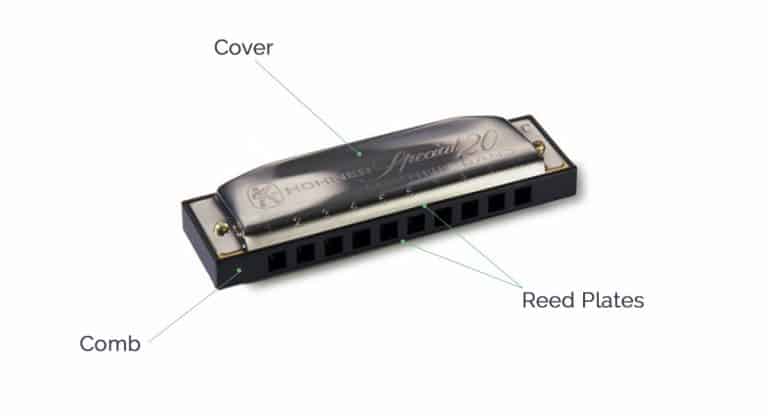
Let’s start with the easiest section first: the cover. These are the outer plates that enclose the instrument, both to protect the interior components from damage and to add resonance to the tone. They’re usually made of metal, with stainless steel and chrome being popular choices. In the extreme high end of the harmonica world, you’ll find covers made of silver and other expensive metals that can greatly alter the instrument’s sound. The materials used in the under $1,000 category have less of an impact on tone.
The comb or body of the harmonica is what makes up the bulk of the instrument. It’s the rectangular portion between the cover plates. It holds the reeds and contains the holes you blow into to produce sounds. Unlike with covers, you’ll find a huge variety of materials being used to make the comb—and an equally wide array of opinions about which material is best.
Traditionally, the comb was made from wood. You will sometimes still see wood utilized in modern harmonicas, but it’s more common to see combs made of either metal or plastic. The polymer ABS (acrylonitrile butadiene styrene, for the science folks out there) is a popular choice because of its durability. You’ll also find a lot of different metals used, from inexpensive minerals like aluminum to rarer metals like titanium in high-end models.
There’s some debate in the professional community about how much impact the comb material has on the sound, but there’s no question it’s one of the main factors in the instrument’s longevity and playability. While traditionalists prefer wood combs, most modern players would rather use plastic or metal. Wood tends to warp from humidity, making it harder to play over time. Metal and plastic are also easier to make air-tight, very important for an even response across the instrument.
The sound of a harmonica is produced through vibrations of the reeds, which are flat pieces of metal secured at one end. The free end responds to your air, blocking and unblocking the various holes and making the sound. It’s universally agreed the material used in the reeds has a big impact on the harmonica’s tone, and are arguably the most important single aspect of the instrument to consider.
Brass is the most common reed material, but other metals are often used. Stainless steel is one popular option, as is silver, and you may see techniques like chrome plating employed, too. In general, the heavier and harder the metal, the darker and warmer the resulting sound will be. Harder metals are also more durable, meaning your reeds will last longer before you have to change them.

A bend is an important stylistic element in the harmonica tone. This is the term for when a harmonica player uses their lips and air to scoop into the tone, or gradually lower and raise the pitch within a note to give it more expression. Deep bends are especially important for blues players, though most harmonica players use them to some extent. The material used in the reeds will be the most important factor if you’re looking for a harp that lets you bend notes easily.
When it comes to a diatonic harmonica, the key it’s it will tell you which notes you’ll be able to play on it. A diatonic harmonica plays all the notes on the major scale of the given key. This doesn’t necessarily mean that’s the only key it can play in; jazz players especially may want to use the harmonica a fifth away from their key to give it a blues scale sound.
Which keys (and how many keys) you’ll need in your arsenal is a matter of personal preference. Most players start with the key of C, which is a good all-purpose baseline key since it’s the most common key across genres. Expanding from there, the keys of G, D, and A are the most-used in the harmonica’s main genres of folk, blues, and rock.
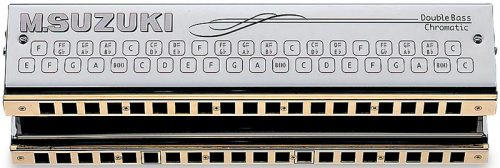
Choosing just one harmonica that’s hands-down the best is a tricky proposition since so many of the decisions involved in choosing an instrument are very personal.
The right harmonica for a given player really depends on what kind of sound they’re looking for, what genres they play in, and how advanced they are in terms of technique.
Any of the harmonicas on the list above is the right choice for a certain kind of player. By considering the questions and options in the buyer’s guide, you’ll be able to narrow down your search to a few key options.
Don’t forget to let your ears play a role in your final decision, either. Doing the right research
before you buy is the best way to make sure you get the right harp for your needs.
Or, do we did and went with the harmonica we thought was the best of all them.
Check it out:
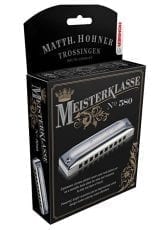
Which are the best harmonicas? You can find out here. Take a few seconds and easily compare several top rated harmonicas.
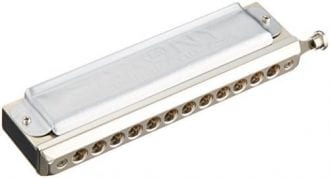
Which are the best harmonicas? You can find out here. Take a few seconds and easily compare several top rated harmonicas.

Which are the best harmonicas? You can find out here. Take a few seconds and easily compare several top rated harmonicas.
If you’re just starting out, a diatonic harmonica in the key of C will be the ideal option. Either the Hohner Marine Band or the Lee Oskar Major Diatonic is a great place to start.
Generally speaking, no. The harmonica is one of the lowest-maintenance instruments you can buy. If you travel with your harmonica a lot, you may want to consider buying a case to protect it from dust and damage. A soft-sided case should serve your purposes fine, especially for instruments with metal and plastic combs. Many of the options above come with cases; if this is something you think you’ll want, consider buying an option that comes with a case already and save yourself a few bucks in the process.
If the reed fractures completely, you’ll know because the instrument will stop producing sound from that hole. If it’s simply damaged or misaligned, you may notice the sound from that hole is buzzy or dull. It may also be airy or blow inconsistently. Changing a reed isn’t difficult. There’s quite a few excellent step by step instructions available online. This post from Andrew Zajac is an excellent beginner’s guide.
The best bet is to buy replacement reeds from the same company that made your harmonica. These will be guaranteed to fit correctly in the instrument’s slots and will be most likely to give you a tone that’s consistent with the other reeds in the instrument.
This is a common issue for beginning chromatic harp players and usually stems from your embouchure (the way you hold your mouth while you’re playing). Everyone’s mouth is a bit different, so there’s no one answer to fix this. Try holding your mouth in a few different positions, and consider consulting a music teacher if you can’t make it sound on your own.
